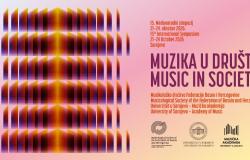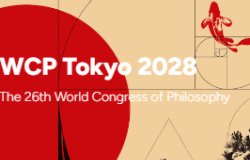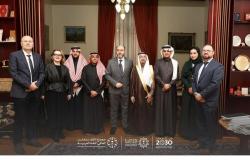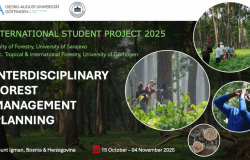The 75th Anniversary of the UNSA Faculty of Architecture Celebrated

On 5 April 5, the Faculty Day, the beginning of the celebrating the 75th Anniversary of the Faculty of Architecture, University of Sarajevo was held in the Burence hall. In the introductory presentation, Dean, Prof. Dr. Erdin Salihović looked back on the long and rich period that preceded the 75th anniversary and announced the Jubilee celebration program until the end of the current year.
On this occasion, the electronic edition and the first printed hard copy of the monograph “University of Sarajevo - Faculty of Architecture 1949 - 2024: 75 Years of Architect Education in Bosnia and Herzegovina” was presented. The official promotion of the Monograph, which will be held in May 2024, was announced by the vice-dean and chief and responsible editor V. Prof. Dr. Nermina Zagora.
In the continuation of the program, the awarding of the Faculty's annual awards took place. The awarding committee consisted of: V. Prof. Dr. Elša Turkušić Jurić – president, Prof. Dr. Lemja Chabbouh Akšamija, Prof. M.Sc. Sabrija Bilalić, V.Prof. Dr. Nihad Cengić, V.Prof. Dr. Vedad Islambegović and Assoc. Prof. Dr. Haris Bradic.
THE MUHAMED KADIĆ AND REUF KADIĆ AWARD – FOR LIFE'S WORK AND CREATIVE PROGRESS IN ARCHITECTURE WAS GIVEN TO PROFESSOR DUŠAN ĐAPO.
 Explanation:
Explanation:
The "Muhamed i Reuf Kadić" award is based on achieved principles of excellence and high academic and professional standards, recognized creative potential and creative breakthrough in architecture.
Retired university professor dr. Dušan Đapa is a significant participant in the processes of creating modern architectural expression in the areas of the former Yugoslavia, which is recognized as an inseparable segment of the European architectural and cultural context. Professor Đapa completed elementary school and high school in Sarajevo, and graduated from the Technical Faculty in Sarajevo in 1959. He started working in the design office "Plan" in Sarajevo, and his career in academia began in 1961 as an assistant at the Faculty of Engineering - architectural department, teaching Architectural Constructions I, II, III. In 1967, he spent 6 months on specialization at the Faculty of Architecture in Leningrad, while in 1977 he was habilitated in Sarajevo and elected to the position of assistant professor. By defending his doctoral dissertation in 1989 at the Faculty of Architecture in Sarajevo, he earned the title of Doctor of Architectural Sciences. Professor Đapa has been a permanent associate since the establishment in 1966 of the Institute for Architecture, Urban Planning, Construction and Communal Affairs, realizing significant projects in various areas of design. He has been awarded many professional and social awards, among which the following stand out: the Sixth of April award of the city of Sarajevo, the University of Sarajevo plaque, the commemorative plaque of the Winter Olympic Games, the "Borba" magazine award for the best architectural achievement in Bosnia and Herzegovina and for the best architectural achievement in Yugoslavia, and the Collegium Artisticum jubilee salon awards for the best architectural realization and the best architectural idea. His work, the Zetra Sports Hall in Sarajevo, which he created in collaboration with his colleague architect Lidumil Alikalfić, is one of the most significant achievements of the modern architectural heritage of Bosnia and Herzegovina and beyond. He has been a member of the Association of Fine Artists of Applied Arts and Designers of Bosnia and Herzegovina since 1965.
THE JAHIEL FINCI AWARD – FOR OUTSTANDING CONTRIBUTION TO THE IMPROVEMENT, DEVELOPMENT AND PROMOTION OF THE ARCHITECTURAL PROFESSION WAS GIVEN TO PROFESSOR NIHAD ČENGIĆ.

Explanation:
The "Jahiel Finci" award is based on many years of public engagement and demonstrated organizational abilities of an individual, aimed at the advancement, development and promotion of the architectural profession. The commission believes that the modernity of architectural expression and culture in Bosnia and Herzegovina is truly linked to the experiences of architects who participated in the exchange program of AFS students with ETSAB, whose realization is due to Prof. Dr. Nihad Čengić. This confirms that often such organizational activities, although insufficiently visible to the public, are more important in the long term for the education and culture of a society precisely because of their continuum.
The first international student and teacher exchange program, after 1995, was established by AFSarajevo in 2000 with the Faculty of Architecture ETSABarcelona. The foundations of this program were laid out in 1997, when AFS organized a large international workshop on Urban DisContinuity. Workshop participant, prof. Jordi Ros Ballesteros then invites Nihad Čengić to establish a long-term cooperation between our two faculties. Together, as co-directors, they realized the BCN-SJV seminars in 1998 and 1999 in Barcelona and Sarajevo. With the support and engagement of prof. Aquiles Gonzales Raventosa and with the fact that Barcelona gave Sarajevo the status of its tenth municipality, and based on the previous results, the student and teacher exchange program was promoted and accepted, and Nihad Čengić was appointed by ETSAB as its coordinator. The close bonds of individuals were then built, and later grew into collective success
Prof. Ballesteros and Prof. Raventos are winners of the AFS charter in 2004 for their contribution to the post-war reconstruction and development of our faculty. Barcelona fully financed the program, categorized as quasi-Socrates, given that no European funds for higher education were available to Bosnia and Herzegovina. About 35 AFS students participated in the exchange program. Unfortunately, the student from Barcelona was not interested in studying at AFS. For the first 10 years, the exchange program included a free one-year education and a job in the planning and design departments of the City of Barcelona. In the first year of the exchange, students gained practical knowledge in the project offices of their teachers, who supported the program with interest. Later, jobs and internships for students were not available. Bilateral agreements between the two faculties were first signed for each year, and later, with the growth of confidence and success of our students in studies and in practice, the agreements were signed for several years. The success and dedication of our students to learning and practice were clearly recognized by ETSAB teachers and professionals from the City Departments. The exchange program of students and teachers between the faculties of architecture AFS and ETSAB has been going on for 22 years. Thirty-five male and female architects, over the course of two decades, gained 20% of their knowledge and experience in Barcelona and transferred it to Sarajevo and BiH and shaped it. This influence is not measurable, but it must exist. Almost one third of these students are today teachers at AFS and at other universities in Bosnia and Herzegovina or in Europe. The Sarajevo School of Architecture, from the beginning of the XXI century, in education and practice, also carries the breath of the Barcelona School, similar to how it carried the breath of the Prague School of Architecture in the 50s.
JURAJ NEIDHARDT AWARD - FOR THE MOST SUCCESSFUL STUDENT'S FINAL THESIS AT THE UNIVERSITY OF SARAJEVO - FACULTY OF ARCHITECTURE WAS GIVEN TO STUDENT ZEJNEB BASARIK (MENTOR: V. PROF. DR. NERMINA ZAGORA).
 Explanation:
Explanation:
The work shows exceptional graphic and presentation quality, which supports complex program content with adequate illustration language. At the same time, numerous detailed plans document one of the most significant contemporary architectural achievements in Bosnia and Herzegovina, as well as beyond. The author responds to the not-so-simple task of adapting and redesigning an abandoned hotel space, which is characterized by the unique design language of academician Zlatko Ugljen translated into total design, with a clear methodological approach that includes references to: the limitations of the found physical framework, the original aesthetics of the sequence of spatial environments and the current social milieu of the city High. The author therefore worked skillfully and with creative subtlety as a designer not only in the interior, but also in the external appearance of the object, as much as was necessary for its adaptation to today's standards. As a final result, a pleasant interior environment was achieved, which is dominated by light tones and wood as a material, not diminishing the visibility and importance of the original values of Hotel Visoko.
THE DUŠAN SMILJANIĆ AWARD – FOR THE MOST SUCCESSFUL STUDENT SEMESTER WORK AT THE UNIVERSITY OF SARAJEVO – FACULTY OF ARCHITECTURE WAS AWARDED TO STUDENT MARKO VLAISAVLJEVIĆ (MENTOR: V. PROF. DR. VEDAD ISLAMBEGOVIĆ).

Explanation:
The graphic and presentation processing of the work is at a very enviable level. The greatest value of this work is that it graphically and programmatically illustrates the concept of a possible and necessary humane character of a residential complex. The choice of materials and colors, the playfulness of the facade cladding, the pronounced linearity of the three-story volumes only complement the skillful residential arrangement of three residential and commercial buildings (with an underground garage) around a triangular green "inner courtyard". Such a recognizable ensemble provides a certain level of individuality and unobstructed views, and enables the dominance of the park's greenery. The presented internal residential layout certainly results in other optimal solutions. The end result in which the apartment, as a future home, becomes an inseparable part of the outdoor environment, and vice versa, has been achieved.
HUSREF REDŽIĆ AWARD - FOR THE MOST SUCCESSFUL STUDENT SCIENTIFIC RESEARCH WORK AT THE UNIVERSITY OF SARAJEVO - FACULTY OF ARCHITECTURE WAS GIVEN TO DR. SCI. JELENA BAJIĆ ŠESTOVIĆ (MENTOR: V. PROF. DR. JASENKA ČAKARIĆ).

Explanation:
The doctoral dissertation updates the topic of the influence of the process of social transition on the development of public spaces, setting the topic within local frameworks, but in such a way as to offer a clear methodological pattern that can simultaneously valorize, understand and improve open public spaces within similar and different urban localities. The value of the work is additionally reflected in the fact that the author chronologically and typologically explains all terms related to this topic by comparison, thus offering a possible textbook for understanding urban issues.

























